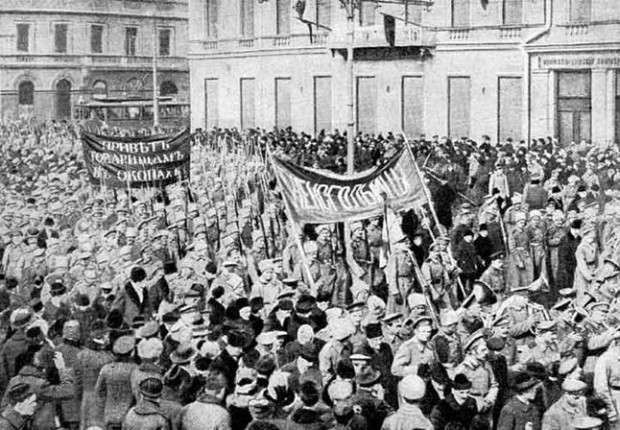February Revolution of 1917
February Revolution of 1917. The second revolution (after the Revolution of 1905) in the Russian Empire, which led to the collapse of the tsarist regime and the inauguration of a democratic, republican government. Russia was weakened at the time by military failure, an economic crisis, and public discontent. The working class wanted better living and working conditions, the peasants wanted more land, and the oppressed nationalities wanted freedom. Almost everyone wanted an end to the war with the Central Powers.
The immediate causes of social unrest were the military losses and disorder at the front and the food shortages in Petrograd. There the Putilov factory went on strike on 2 March (OS 17 February) 1917, and Petrograd's workers took to the streets. On 12 March (27 February) they were joined by the soldiers—the guard regiments that contained many Ukrainians, such as the Volhynian Regiment, which had ties with the Ukrainian Social Democrats and with Volodymyr Vynnychenko. That day the Russian State Duma, under the leadership of Mykhailo Rodzianko, assumed power in Russia and constituted the Provisional Committee to direct the revolution. On 15 (2) March the committee formed the Provisional Government, which was headed by Prince G. Lvov (a liberal zemstvo leader) and composed of the Kadets (Pavel Miliukov), Octobrists (A. Guchkov), Socialist Revolutionaries (Aleksandr Kerensky), Social Democrats (N. Chkheidze), and independent members (M. Tereshchenko and others). The Bolsheviks were opposed to the Provisional Government. By dominating the increasingly more radical soviets of workers' and soldiers' deputies, they succeeded in creating a situation of dual authority. On 15 (2) March Nicholas II abdicated, and the Provisional Government replaced the tsar's high administrators (governors) with its own gubernial commissioners and county commissioners throughout the empire, including Ukraine. During the revolution the Ukrainians organized their own representative body—the Ukrainian National Council in Petrograd. It was headed by Oleksander Lototsky and demanded national rights for Ukraine from the Provisional Government. There was also a Ukrainian faction (headed by Oleksander Shulhyn) in the Petrograd Soviet of Workers' and Soldiers' Deputies.
The revolution quickly spread throughout the Russian Empire. On Russian ethnic territory the revolution was primarily a social one; on non-Russian territories it was mainly a national revolution. Ukrainians organized their own associations and demanded recognition for their language, Ukrainian schools, and their own distinct military formations.
In Kyiv the Central Rada was established to direct the Ukrainian national movement. Mykhailo Hrushevsky presided over the Central Rada, which, after convening the All-Ukrainian National Congress on 19–21 April 1917, became Ukraine's revolutionary parliament. Various Ukrainian political parties became active in this period: the Ukrainian Social Democratic Workers' party, Ukrainian Party of Socialist Revolutionaries, Ukrainian Party of Socialists-Federalists, Ukrainian Party of Socialists-Independentists, Ukrainian Democratic Agrarian party, and others. Various occupational associations and unions were also very active and elected delegates to the Central Rada.
From the beginning of the revolution the tsarist prohibitions against the Ukrainian language ceased to have any force, and Ukrainian was gradually introduced in the schools, administration, press, and publishing. The Ukrainian cultural and civic movement engulfed all Ukraine.
At the beginning of the revolution two governments competed in Ukraine: the Russian Provisional Government with its commissars, and the Central Rada with the General Secretariat of the Central Rada, which was formed later. The Provisional Government soon lost its influence in Ukraine, and its functions were assumed by the Central Rada.
In general the February Revolution was carried out in a more peaceful and organized way in Ukraine than in Russia. Many massive rallies, demonstrations (photo: demonstration in Vinnytsia, 1917), congresses, and so on were staged without bloodshed. Besides social change the struggle for national, political, and cultural rights played a primary role in the Ukrainian revolution. Gradually national rights, followed by autonomy, and finally independence were achieved. (See also October Revolution of 1917.)
BIBLIOGRAPHY
Khrystiuk, P. Zamitky i materiialy do istoriï ukraïns’koï revoliutsiï 1917–1920 rr., 1 (Vienna 1921–2; repr New York 1969)
Doroshenko, D. Istoriia Ukraïny 1917–1923 rr., 1 (Uzhhorod 1932; repr New York 1954)
Chamberlin, W. H. The Russian Revolution 1917–1921, 2 vols (New York 1935; repr 1965)
Chernov, V. The Great Russian Revolution (New Haven 1936)
Reshetar, J.S. The Ukrainian Revolution (Princeton 1952; repr New York 1972)
Velikaia Oktiabr’skaia sotsialisticheskaia revoliutsiia na Ukraine. Fevral’ 1917–aprel’ 1918: Sbornik dokumentov i materialov, 1 (Kyiv 1957)
Browder, R.P.; Kerensky, A. (eds). The Russian Provisional Government, 1917: Documents, 3 vols (Stanford 1961)
Kharytonov, V. Liutneva revoliutsiia 1917 roku na Ukraïni (Kharkiv 1966)
Hunczak, T. (ed). The Ukraine, 1917–1921: A Study in Revolution (Cambridge, Mass 1977)
Arkadii Zhukovsky
[This article originally appeared in the Encyclopedia of Ukraine, vol. 1 (1984).]

